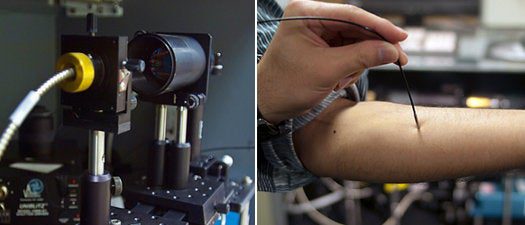It’s a typical scenario: you ask the doctor to make you feel better; he or she proceeds to stick you with needles and bombard you with radiation. But a new breed of portable devices painless laser beams could use Raman spectrometry to diagnose conditions inside the body and put an end to X-rays and even blood drawing, in just a few years.
Raman spectroscopy is commonly used in chemistry and pharmaceutical research to identify molecules through the wavelength and intensity of laser light as it scatters when passing through them. But though it’s been used to analyze human cadavers, the technology could soon become a cheaper, faster, and more reliable method of diagnosing illnesses and conditions in vivo.
When a person is sick the chemical makeup of their tissues changes. By firing a laser at that tissue, Raman spectroscopy can analyze the tissue – without removing it from the body – to identify it as either healthy or not, via the unique molecular signatures in the light as it scatters. Depending on what the physician is looking for, that signature can be markedly different – say, in the case of a developing tumor – or just slightly different. But more sensitive instruments under development can pick up those nuances, making for a far less-invasive diagnostic tool.
The technique could be used to diagnose everything from early stages of tooth decay to high cholesterol (without drawing blood). For health care systems around the world that are strapped for cash, the advance could be monumental given the fact that Raman spectroscopy could replace a battery of more expensive diagnostics and cut down on time-consuming lab work.
For instance, researchers think the technique could not only replace the typical mammogram but actually do a better job; by diagnosing a growth as malignant or benign without requiring an actual biopsy – and between 80 percent and 90 percent are benign – Raman spectroscopy could reduce the number of unnecessary biopsies by 80,000 per year in the UK alone by some estimates. Extrapolate that across the entire globe and an entire universe of ailments, and that cuts down on a lot of unnecessary time, and money, spent at the doctor’s office.









